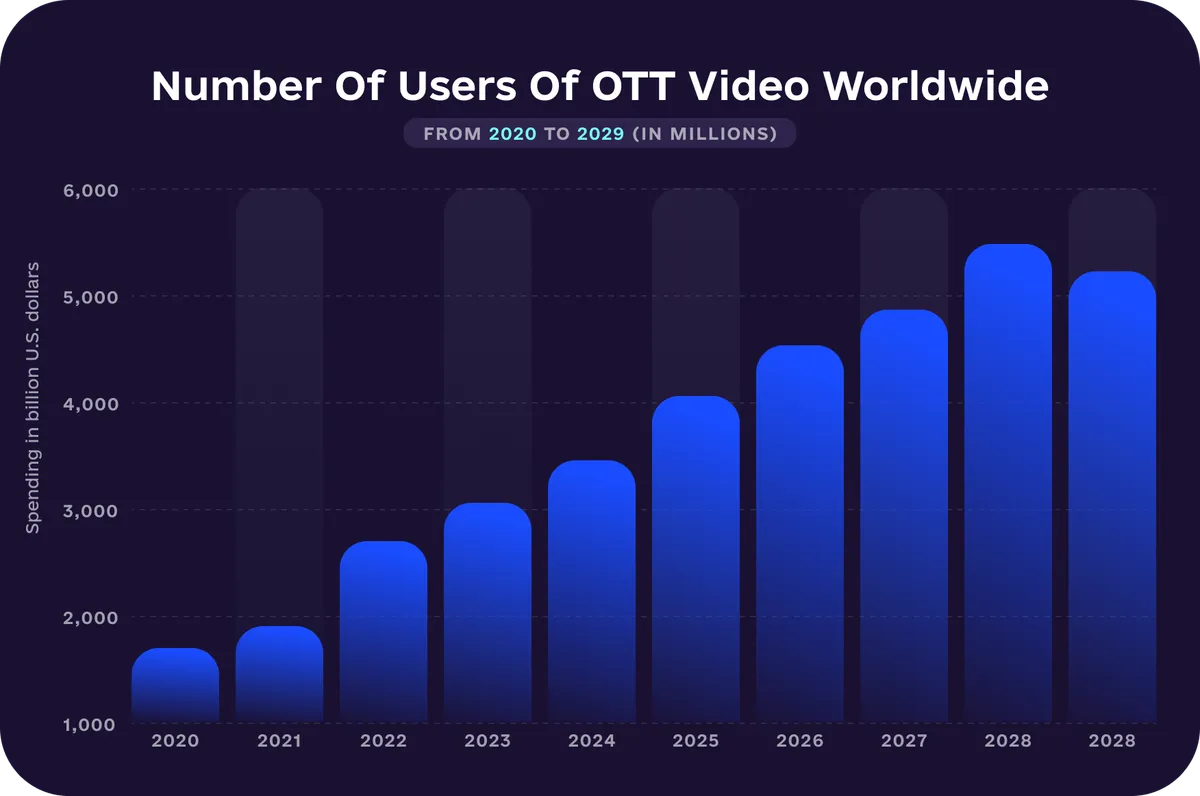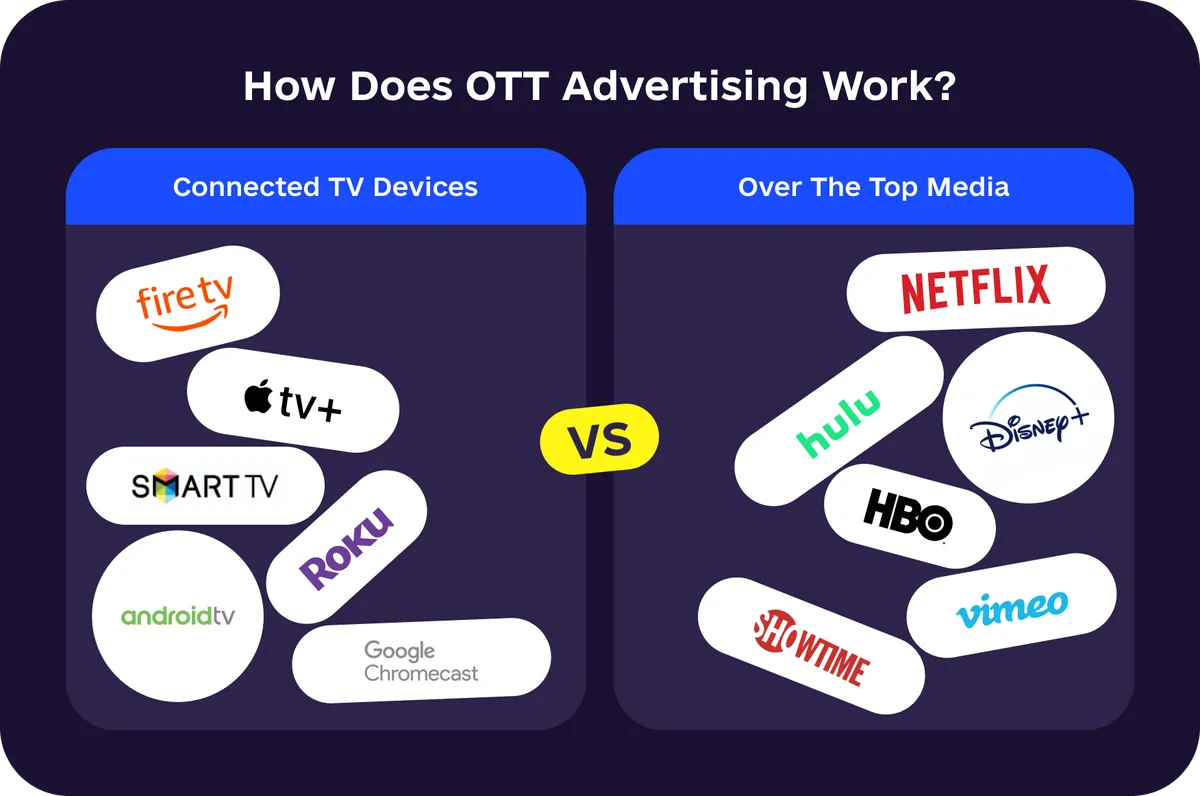OTT marketing is getting more and more popular — according to Statista, it is projected to reach a market volume of almost $270 billion by 2029, while for the year 2025, the expected rate is around $207 billion.

But what is OTT digital advertising? How does it work? Why is demand for it growing? In this article, we are going to answer these and other questions, so keep reading to learn more.
Key Takeaways
OTT (over-the-top) advertising delivers ads over the internet via platforms like Netflix, YouTube TV, or Crackle, and includes various formats such as pre-roll, mid-roll, overlay, and banner ads.
OTT enables precise audience targeting, cross-device delivery, and real-time optimization, offering better engagement than traditional TV due to contextual relevance and ad-supported models.
Key ad formats include pre/mid/post-rolls, overlay banners, and CTV-compatible units, delivered via SSAI or CSAI technologies.
Marketers benefit from privacy-compliant targeting, detailed analytics, and high ROI potential, despite challenges like fragmentation, ad blockers, and limited measurement across platforms.
Attekmi’s ad exchange solutions support CTV ads, which allows owners to drive media trading income more effectively.
What is OTT advertising?
OTT (which stands for “over the top”) advertising implies delivering advertisements to users over the Internet via streaming media services like Netflix, HBO, and others.
OTT in advertising is often confused with CTV. However, it is important to remember that CTV advertising is a subset of OTT marketing. Basically, CTV refers to devices that are used to view the content (smart TVs, gaming consoles, etc.), while OTT is the method of delivering this content. This way, OTT ads can be viewed via CTV devices as well as, for instance, on laptops that do not fall under the CTV category.

How does OTT advertising work?
The delivery process of OTT ads depends on two factors: the way the platform communicates with the devices (for example, via VPAID or VAST tags) and the method of ad insertion (CSAI or SSAI).
VAST (Video Ad Serving Template) tags provide the player with instructions regarding the ad: how long it should be played, how exactly it should show up, and so on.
VPAID (Video Player-Ad Interface Definition) tags are a better version of the VAST ones — they enable interactivity (in some cases) and viewability measurement.
CSAI (Client-Side Ad Insertion) implies loading the ads into the OTT box before they are displayed. Currently, this method is the leading one, even though it is prone to ad blockers.
SSAI (Server-Side Ad Insertion) enables ads to be served as a seamless stream. It mixes ads with the main content frame-by-frame, which allows the advertisements to bypass ad-blocking software.
Benefits of OTT advertising
Now that the definition of OTT advertising and its principles of work have been clarified, let’s explore the specific benefits of this type of marketing.
The growing popularity of OTT marketing
As we already mentioned, marketers increase their investments in OTT advertising. Therefore, integrating this type of marketing into the strategy is your opportunity to remain competitive and reach your target audience effectively. Besides, the earlier you try OTT marketing, the better. In case you succeed, you may get a chance to overcome those of your competitors who neglect OTT advertising.
Accurate OTT targeting
In the era of traditional TV advertising, precise targeting was simply impossible. For instance, marketers could not specify the demographics of the viewers or their location — the ad was just delivered to a specific TV channel. However, that is in the past.
Modern OTT advertising platforms, including programmatic ones, allow you to specify multiple characteristics of your audience so that you can be sure that your ads will reach exactly those viewers who are most likely to convert.
Besides, with a cross-channel approach, you can target and retarget the same audience across different screens and channels. For example, first, you launch an OTT TV advertising campaign, then retarget it as a display campaign on specific websites, etc.
Certain resistance against growing privacy concerns
Modern customers are getting more and more concerned about their privacy. As a result, third-party cookies are about to fade away completely, so marketers need to adopt privacy-first solutions to keep advertising effective.
OTT ads delivered to CTV devices offer a solution to this challenge — TV screens simply do not have cookies. Therefore, when third-party cookies are eliminated, TV advertising will not be affected.
High engagement
As you already know, OTT marketing and CTV advertising are not exactly the same thing. However, many viewers prefer to watch OTT content on their smart TVs. The size of their screen allows you to deliver an engaging and immersive experience to your potential customers (although it is important to make sure that your ads are of high quality). Additionally, such ads are just more complicated to ignore.
One more fact to mention here is that over 75% of streaming audiences (in the USA) use at least one ad-supported service. Many platforms offer subscriptions that support advertising content — the key reason for doing so is their strive to increase the number of subscribers. For you, this means an opportunity.
Besides, since modern advertising implies accurate targeting, you can deliver highly relevant and personalized ads, which ensures greater engagement.
Monitoring capabilities
Traditional TV advertising offered close to zero monitoring opportunities. Fortunately, OTT marketing enables easy analysis and performance tracking. Advertising platforms are equipped with multiple monitoring features, so it is easy for you to analyze the performance of your campaigns and, as a result, detect weaknesses and opportunities.
Real-time optimization
Thanks to advanced analytics capabilities, you can optimize your campaigns in real time to reach your goals more effectively. This also includes ad spend optimization. For instance, you can limit the day spend or spend for campaigns with lower performance — you simply have full control over your OTT advertising cost.
Types of OTT ads
OTT ads come in different formats, so let’s take a closer look at them:
Pre-roll ads. Usually lasting for 15-30 seconds, these ads are shown before the main OTT content begins. Due to this, they have high visibility and are effective in terms of drawing attention. However, pre-roll ads can be considered annoying by viewers.
Mid-roll ads. These ads are typically longer than pre-roll ones — from 30 seconds to several minutes, which provides you with greater opportunities to deliver your message effectively. They are shown in the middle of the content after a user has watched a certain part of the video. Make sure to select the placement timing carefully (if possible); otherwise, your ad may annoy the viewers.
Post-roll ads. The length of these OTT ads can also reach several minutes. They appear after the main content ends and can be effective in terms of attracting attention. However, some users may still ignore post-roll ads since they have finished watching the content and may be ready to leave the platform.
Overlay ads. These ads can be seen on the top of the content (however, they do not interrupt the viewing experience). Typically, they contain links that lead viewers to landing pages, which is a great benefit. At the same time, overlay ads do not provide a lot of space for your advertising message.
Banner ads. These ads are static creatives. They appear at the bottom or top of the screen. While the content is played, they are visible constantly and do not interrupt the experience. However, they offer limited space for your message, so it may be complicated for banner ads to attract attention.
Keep in mind that it would be useful to experiment with different types of OTT ads. This way, you will be able to identify those that ensure the best performance for your specific campaigns.
Types of OTT platforms
OTT is not only about Netflix subscriptions — there are several types of platforms available. Explore them to get a better understanding of OTT digital advertising.
Subscription-based video on demand
Subscription-Based Video on Demand (SVOD) is a streaming service where viewers pay a recurring fee to access video content: these can be movies, TV shows, original content, etc. Users have unlimited access to the content without any commercial interruptions. Netflix and Amazon Prime Video are great examples of SVOD platforms.
Transactional video on demand
Transactional Video on Demand (TVOD) implies accessing video content on a pay-per-view basis. Thus, users purchase or rent specific movies or shows and usually have to watch the content within a certain period of time. Otherwise, the access expires. Most often, the TVOD approach is used for one-time events (like concerts) and new releases that are not yet available on subscription-based platforms. Amazon Prime Video Store can serve as an example here.
Advertising-based video on demand
Advertising-Based Video on Demand (AVOD) is about delivering content over the Internet and offering it to viewers for free. However, users have to watch ads during playback, and this is how such content is monetized — through advertising. For example, this is exactly how Crackle works.
Premium video on demand
Premium Video on Demand (PVOD) is a model where users can purchase or rent video content that has just been released before it becomes available on subscription-based services and traditional media like DVDs. PVOD allows viewers to enjoy premium content (typically, new movies or TV shows) without the need to go to the cinema or wait until it appears on other OTT streaming services. The titles are available for rent for a limited time (typically 48 hours), and the price is usually higher than on other platforms.
Virtual multichannel video programming distributors
Virtual Multichannel Video Programming Distributors (vMVPD) are streaming services providing users with access to a specific number of live TV channels delivered over the Internet. For example, YouTube TV is among vMVPD services.
How to create an OTT advertising strategy
Preparing the strategy and launching OTT campaigns works in the following way:
Thorough planning.
First of all, you have to plan everything carefully: decide on the goals of the campaign, understand your target audience (which involves collecting data about their locations, viewing habits, preferences, and so on), etc.
Selecting OTT media platforms.
There are a lot of OTT advertising platforms to choose from, and you should choose those that are relevant to your target audience. However, keep in mind that you may be limited to free-to-watch platforms, as they support advertising content. In any case, consider cross-platform OTT marketing. Reaching your target audience across multiple platforms and devices will help you improve the exposure of your ads and reach better results.
Creating advertising content. After everything is planned, you need to create content matching their objectives. It is essential to remember that OTT advertising is a rather competitive environment, so the content should be unique and catchy. It would be helpful to check out the content of competitors to make sure that your ads are different and draw attention.
Besides, make sure to create high-quality content.
If the quality is low, it will be challenging for your ads to drive conversions. You should also add a clear and compelling call to action (CTA) and, if possible, make your OTT ads contextually relevant to the content being streamed on the selected platform (or platforms). This way, your advertisements will look more engaging.
Getting ready to purchase ad inventory.
In many cases, ad space can be bought directly from the platform. For instance, you can submit a request to Netflix and provide them with your details. Alternatively, you can go for programmatic advertising, which is a more convenient way to reach your audience. In this case, you may need to select a DSP supporting your ad format (if you have not done this yet). Keep in mind that CTV advertising also refers to OTT advertising, so a DSP supporting the CTV format can be a great choice.
Segmenting the audience. T
o keep your OTT advertising campaign more effective, you should segment your target audience according to their demographic characteristics, behaviors, interests, and so on. This will allow you to be more specific when setting up your campaign. As a result, your ads will reach those viewers who are most likely to get interested in your products or services. Besides, the content itself will become more personalized.
Setting everything up.
After you make all the essential decisions, you need to set up your campaign on the selected platform. This involves targeting settings, scheduling, etc. In terms of targeting, provide as many details as you can.
Launching the campaign.
The next step is to launch your campaign. Note that if you prefer to advertise programmatically, the platform will do the rest after everything is set up. Automatization is among the key benefits of OTT programmatic advertising (and not only OTT), and the auctions take less than a second to complete.
Tracking the performance.
After the campaign is launched, you need to monitor its performance continuously. This way, you will be able to optimize your campaign on time and reach better results. The metrics to pay attention to usually include click-through rate, return on ad spend, conversion rate, and some others. However, you need to make a choice according to your goals. If you detect any weaknesses or opportunities, do not hesitate to adjust your strategy.
Creating reports.
Finally, you should prepare reports describing the performance of your campaign. The insights you gather will help you launch more effective campaigns in the future.
Keep in mind that, when possible, it would also be helpful to run A/B tests. This implies running multiple versions of an ad simultaneously. As a result, you can identify the most effective one in a data-driven way and gain useful insights on how to improve your future OTT advertising campaigns.
OTT advertising examples
Now, let’s review several examples of successful OTT ads from well-known companies. Here is some inspiration for you:
Coca-Cola: the “Real Magic” campaign
Lasting for 29 seconds, Coca-Cola’s “Real Magic” ad features different people and, therefore, resonates with different audience groups. The ad showcases heartwarming shared moments and experiences, which are exactly the “real magic” in everyday life. Due to this, the ad resonated with customers across the globe and helped Coca-Cola build a deeper emotional connection with its audience. The short length of the video is another benefit — watching an ad does not make viewers feel bored or annoyed. Feel free to check out the video here.

Apple: the “Privacy. That’s iPhone” commercial
In the modern world, privacy has become a crucial topic, and Apple saw this as an opportunity. They released the “Privacy. That’s iPhone” campaign featuring people sharing the information that should be kept secret — not only credit card details but also something personal. Then, the iPhone is introduced as a solution that ensures security for all the information you have. The commercial turned out to be really engaging and funny, even though it lasted for more than 1 minute. It resonates with customers effectively since virtually everyone has experienced data security issues (both serious and not). Take a look at Apple’s ad here.

Nike: the “Play New” campaign
Nike’s commercials are pretty motivational in general — everyone knows their “Just do it” motto. However, the “Play New” ad goes even further. Targeting different audience groups with personalized messages showcases loads of sport-related failures in a funny way and highlights the importance of trying to do something you have never done before and not being afraid of failure. Everyone fails sometimes, but this is not the reason to stay in your comfort zone forever — Nike’s message illustrates this perfectly, and you can take a look at their ad here.

NAADAM: "The Democratization of Cashmere" ad campaign
NAADAM is a Mongolian manufacturer of affordable cashmere clothing. To tell the company’s history and highlight its commitment to ethical and sustainable operations, NAADAM launched "The Democratization of Cashmere" campaign. The commercial utilizes storytelling, a lot of humor, and cute animals, and this combination keeps viewers engaged from the first second, even though the ad itself is a bit longer than 2.5 minutes. Besides, the video shows the company’s dedication to fair and transparent labor practices and introduces the viewers to some of the NAADAM’s professionals. You can watch this video here — on YouTube, it has gained 35 million views.

Apple: the “911” campaign
Let’s take a look at one more commercial from Apple — this time, about Apple Watch. In the ad featuring several real incidents, the device is introduced as a potential lifesaver in dangerous situations when you have no access to your phone but need very quick assistance from emergency services. The ad’s message is absolutely clear, and the commercial itself draws attention immediately due to its unusual plot and emotional emphasis. You can watch the ad here (a spoiler — everyone was saved on time, so no worries).

OTT metrics and measurement
Sometimes, OTT advertising can be rather challenging to measure — we will provide more explanations right in the next paragraph. However, tracking the following metrics can still provide you with some actionable insights on how to improve the performance of your OTT digital advertising campaigns:
Ad impressions: the number of times your ad is served or displayed to viewers (it reflects the reach of your campaign).
Conversions: the number of times viewers took the desired action after watching an ad.
Cost per acquisition (CPA): the average amount of money you spend on every successful acquisition (for instance, a sale).
Cost per completed view (CPCV): the average amount you spend on every fully watched advertisement.
Return on ad spend (ROAS): the ratio of revenue you earn to the campaign’s total ad spend.
Gross rating point (GRP): a metric quantifying the part of your target audience that has watched your advertisement.
Cost per point (CPP): a measure of cost-efficiency of your OTT ads.
Click-through rate (CTR): the percentage of users who clicked on an advertisement.
Audience reach: the percentage of unique viewers (within your target demographic) who were exposed to your advertisement.
Frequency: the average number of times an individual user sees your ad within a specific time frame (tracking this metric helps you prevent over-exposure to the same advertising content).
Target rating point: the percentage of your targeted potential customers who view your ads.
Ad viewability: the number of times the impressions were actually considered viewable.
Obviously, the more metrics you monitor and analyze, the better — by doing so, you get a deeper understanding of the performance of your advertising campaigns. However, you should still prioritize the metrics that reflect your goals. Choose them when planning your campaign and outlining the strategy. Do this thoroughly, as the wrong choice may affect the decision-making process when you try to optimize your campaign.
Challenges of OTT advertising
OTT marketing implies multiple benefits, as we described above. However, certain challenges are here as well, and you should keep them in mind.
Ad fraud and regulations. While there are loads of rules and standards for other advertising environments, OTT marketing still lacks them, which contributes to the probability of ad fraud. Yes, OTT advertising is less prone to fraud, but it may still happen. Therefore, it is important to prevent it by choosing a reputable demand-side platform that works only with credible suppliers.
Certain measurability limitations. Obviously, OTT ads are much more measurable than traditional TV advertisements. However, the analytics capabilities are still a bit limited — you may find it challenging to measure the impact of your campaign across diverse platforms and devices. Besides, it can be complicated to integrate the data from various sources. Prefer a programmatic platform with advanced analytics and reporting capabilities. Additionally, you may need to integrate some third-party tools.
Fragmented audiences. There are multiple OTT media platforms, and each of them has its specific audience. As a result, achieving broad reach and consistency can turn into a challenge. Select the platforms and plan your advertising strategy thoroughly.
Ad blockers. As we already mentioned, the majority of users leverage at least one ad-supported service. However, a lot of viewers still prefer ad-free content, which can affect the performance of your campaigns. Besides, there are third-party ad-blocking solutions available for OTT. Unfortunately, there is nothing you can do about ad blockers or ad-free subscriptions. You can only deliver relevant and engaging content that will not motivate viewers to switch to no-ads experience.
eCPM vs CPM: In OTT, eCPM (Effective Cost Per Mille) accounts for all revenue sources, while CPM (Cost Per Mille) focuses on cost per thousand impressions. Understanding both helps optimize ad spend and campaign performance.
Consider Attekmi your trusted partner
So, how can owners of ad exchanges benefit from OTT video advertising? The answer is simple — by offering this type of marketing to your demand and supply partners, you provide them with additional opportunities to reach their goals, which will positively affect your media trading income.
However, building an ad exchange solution that supports OTT marketing can be challenging, time-consuming, and expensive. At Attekmi, we have solved this problem for you.
Our AdEx Basic and AdEx Plus solutions support CTV advertising, so you can enable your demand partners to deliver their OTT ads to CTV devices. Other available formats include banner, video,native, pop and programmatic audio ads. As for additional environments, these are desktop, in-app, and mobile web.
Apart from this, consider choosing our White Label Ad Exchange solution. It is fully customizable, and you can request unique feature development so that the platform will meet all your needs.
For instance, Mobupps achieved 207% revenue growth and 371% ROI, and you can reach the same heights. Find more case studies here to discover how we help our partners succeed.
Does Attekmi look like the right choice to you? Let’s get in touch.
FAQ
Which devices can display OTT ads?
Basically, any device streaming video over the Internet supports OTT ads. For instance, these can be smart TVs, gaming consoles, streaming devices like Roku, personal computers, and smartphones.
What is the cost of OTT advertising?
OTT advertising cost depends on the required targeting precision, inventory quality, seasonal demand, and other factors, so there is no universal answer to this question. However, typically, CPM (cost per thousand impressions) ranges between $25 to $40.
How do I buy OTT ads?
The easiest way to start launching OTT campaigns is via a programmatic demand-side platform. When choosing a solution, pay special attention to its targeting and analytics features, filtering capabilities, and the selection of bidding models. For instance, if a DSP supports not only RTB but also direct deals, that is a good sign.
 By Anastasiia Lushyna
By Anastasiia Lushyna